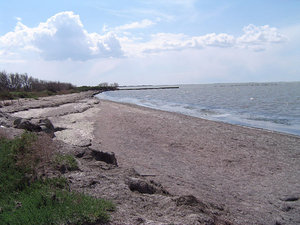Camargue
|
|
The Camargue is the land south of Arles, France, between the Mediterranean Sea and the two arms of the River Rhône delta. The eastern arm is called the Grand Rhône; the western one is the Petit Rhône. Administratively it lies within the département of Bouches-du-Rhône, the appropriately named "Mouths of the Rhône". A further expanse of marshy plain, the Petite Camargue (little Camargue), just to the west of the Petit Rhône, is in the département of Gard.
| Contents |
Geography
With an area of over 930 km² (360 sq. miles), the Camargue is western Europe's largest river delta (technically an island, as it is wholly surrounded by water). It is a vast plain comprising large brine lagoons (étangs) cut off from the sea by sandbars and encircled by reed-covered marshes which are in turn surrounded by a large cultivated area. Approximately a third of the Camargue is either lakes or marshland. The central area around the shoreline of the Étang de Vaccarès has been protected as a regional park since 1927, in recognition of its great importance as a haven for wild birds. The Parc Régional de Camargue was created in 1970.
Flora and fauna
The Camargue is home to more than 400 species of birds, the brine ponds providing one of the few European habitats for the greater flamingo. The marshes are also a prime habitat for many species of insects, notably (and notoriously) some of the most ferocious mosquitos to be found anywhere in France.
The flora of the Camargue is specially adapted to cope with the saline conditions. Sea lavender and glasswort flourish along with tamarisks and reeds.
Regional park
Officially established as a national park and nature reserve in 1972, the Parc Régional de Camargue covers 820 km² that are some of the wildest and most protected in all of Europe. A roadside museum provides background on flora, fauna, and the history of the area.
Human influence
Camargue_baedeker.png
Humans have lived in the Camargue for centuries, greatly affecting it with drainage schemes, dykes, rice paddies and salt pans. Much of the outer Camargue has been drained for agricultural purposes. The Camargue has its own eponymous horse breed, the famous white Camaguais ridden by the gardians who rear the region's fighting bulls for export to Spain, as well as sheep.
There are few towns of any size in the Camargue. Its "capital" is Arles, located at the extreme north of the delta where the Rhône forks into its two principal branches. The only other towns of note are Saintes Marie de la Mer, about 45 km to the southwest, which is the site of the annual Roma pilgrimage for the veneration of Saint Sarah, and the medieval fortress-town of Aigues-Mortes on the far western edge, in the Petite Camargue.
The boundaries of the Camargue are constantly revised by the Rhône as it transports huge quantities of mud downstream - as much as 20 million m³ annually. Some of the étangs are in fact the remnants of old arms of the river. The general trend is for the coastline to move outwards. Thus Aigues-Mortes for instance – on the coast when it was built – is now some 5 km (3 miles) inland. The pace of change has been modified somewhat in recent years by man-made barriers, such as dams on the Rhône and sea dykes, but flooding remains a problem across the region.
External links
- Nacioun Gardians (http://flagspot.net/flags/fr-13_ng.html) (Cultural association, Camargue, France)
- The Carmague at armchairfrance.com (http://www.armchairfrance.com/armchairuzesMarch2004.htm)
- Parc naturel de Camargue (http://www.parc-camargue.fr/) (in French and Italian)

